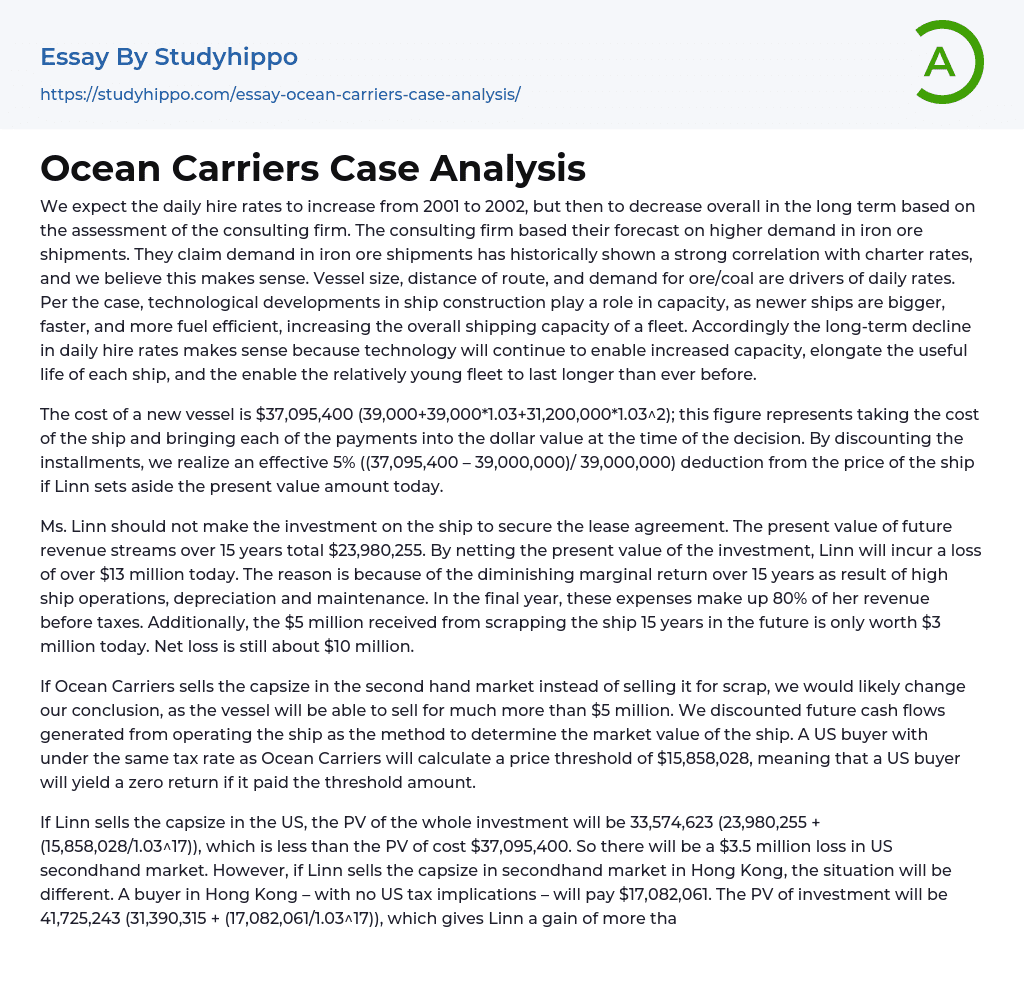We expect the daily hire rates to increase from 2001 to 2002, but then to decrease overall in the long term based on the assessment of the consulting firm. The consulting firm based their forecast on higher demand in iron ore shipments. They claim demand in iron ore shipments has historically shown a strong correlation with charter rates, and we believe this makes sense. Vessel size, distance of route, and demand for ore/coal are drivers of daily rates.
Per the case, technological developments in ship construction play a role in capacity, as newer ships are bigger, faster, and more fuel efficient, increasing the overall shipping capacity of a fleet. Accordingly the long-term decline in daily hire rates makes sense because technology will continue to enable increased capacity, elongate the useful life of each ship, and the enable the relatively
...young fleet to last longer than ever before.
The cost of a new vessel is $37,095,400 (39,000+39,000*1.03+31,200,000*1.03^2); this figure represents taking the cost of the ship and bringing each of the payments into the dollar value at the time of the decision. By discounting the installments, we realize an effective 5% ((37,095,400 – 39,000,000)/ 39,000,000) deduction from the price of the ship if Linn sets aside the present value amount today.
Ms. Linn should not make the investment on the ship to secure the lease agreement. The present value of future revenue streams over 15 years total $23,980,255. By netting the present value of the investment, Linn will incur a loss of over $13 million today. The reason is because of the diminishing marginal return over 15 years as result of high ship operations, depreciation and maintenance. In the
final year, these expenses make up 80% of her revenue before taxes. Additionally, the $5 million received from scrapping the ship 15 years in the future is only worth $3 million today. Net loss is still about $10 million.
If Ocean Carriers sells the capsize in the second hand market instead of selling it for scrap, we would likely change our conclusion, as the vessel will be able to sell for much more than $5 million. We discounted future cash flows generated from operating the ship as the method to determine the market value of the ship. A US buyer with under the same tax rate as Ocean Carriers will calculate a price threshold of $15,858,028, meaning that a US buyer will yield a zero return if it paid the threshold amount.
If Linn sells the capsize in the US, the PV of the whole investment will be 33,574,623 (23,980,255 + (15,858,028/1.03^17)), which is less than the PV of cost $37,095,400.
So there will be a $3.5 million loss in US secondhand market. However, if Linn sells the capsize in secondhand market in Hong Kong, the situation will be different. A buyer in Hong Kong – with no US tax implications – will pay $17,082,061.
The PV of investment will be 41,725,243 (31,390,315 + (17,082,061/1.03^17)), which gives Linn a gain of more than $4.6 million. So the only way to avoid a capital loss is to sell the ship in the secondhand market in Hong Kong.
If financing comes from issuing debt in the capital market, free cash flows will increase because the debt creates cash within the business or project. However, this cash comes at the price of interest
and the company will need to pay this interest moving forward. This additional expense of capital will lower the NPV of the project funded through issuing debt or reduce net income if evaluating the company overall. In this case, if the total future value of principal plus interest is even bigger than the future value of cash inflows when the ship is operating until the date the debt is all paid, issuing debt is not a good idea because they will eventually have bigger burden to pay back in the future.
If the financing of the project comes partially from issuing debt and cash infusion from the owners, the available cash will increase without as much interest expense. This will cause the company books to look bad because of lower EPS, however the company will have a choice not to pay dividends if necessary rather than being bound to pay interest expense. If the IRR of the project is greater than the cost of capital for the owners (in this case 9%), it would make economic sense for the owners to fund the project, at least partially.
- Bank essays
- Banking essays
- Corporate Finance essays
- Credit Card essays
- Currency essays
- Debt essays
- Donation essays
- Enron Scandal essays
- Equity essays
- Financial Accounting essays
- Financial Crisis essays
- Financial News essays
- Financial Ratios essays
- Financial Services essays
- Forecasting essays
- Foreign Exchange Market essays
- Free Market essays
- Gold essays
- Investment essays
- Legacy essays
- Loan essays
- Market Segmentation essays
- Money essays
- Personal finance essays
- Purchasing essays
- Retirement essays
- Shareholder essays
- Stock Market essays
- Supply And Demand essays
- Venture Capital essays
- Income Statement essays
- Net Present Value essays
- Atmosphere essays
- Biodiversity essays
- Coral Reef essays
- Desert essays
- Earth essays
- Ecosystem essays
- Forest essays
- Lake essays
- Natural Environment essays
- Ocean essays
- Oxygen essays
- Rainbow essays
- Sea essays
- Soil essays
- Volcano essays
- Water essays
- Wind essays




